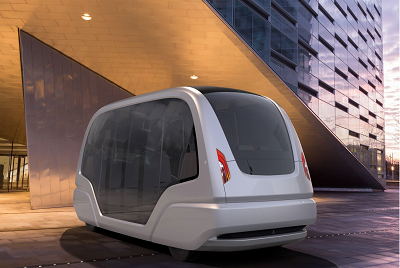Driverless Transit to Dominate in 2040: Planners
Burney Simpson
What will transit look like in 2040? Lots of autonomous vehicles, lots of walking, and a bunch of Uber-style personal transit vehicles.
That was the answer for about two-dozen transportation and transit experts at the Envisioning Automated Transit (EAT) event hosted by the Advanced Transit Association (ATRA).
ATRA is an international non-profit that seeks to increase the knowledge of advanced transit systems. Members include academics, researchers, consultants, and businesses.
ATRA held EAT at the Center for Advanced Transportation Technology (CATT) at the University of Maryland in College Park, Md. ATRA is celebrating its 40th year.
This year, the ATRA leadership met the day before the start of the Transportation Research Board’s 95th Annual Meeting in Washington, D.C.
Participants in the EAT challenge are asked to ‘solve’ the transit needs of a community, though they are only given a few hours to research the area, brainstorm, and come up with a solution. The concept is more to get ideas flowing and ask folks to think outside the box.
“I don’t believe there’s a silver bullet (solution). All ideas will come into play, all have strengths and weaknesses,” said Peter Muller, president of PRT Consulting, and president of ATRA.
This year participants were split into three groups, each one tasked with creating a transit solution for a community in the Washington, D.C., metro area for 2040. The three areas were – downtown Washington, D.C., Annapolis, Md., and White Oak in suburban Maryland.
One assumption – technology will have reached the highest level of automation as described by The National Highway Traffic Safety Administration. That levels means that a vehicle can drive itself, with or without a passenger.
Other than that planners were allowed to be creative in their approach and find something that worked for their area.
*For downtown Washington, the team suggested an auto-restricted area, expanded bike lines and pedestrian sidewalks, consolidated delivery/pick-up areas for freight, and priority transit corridors for autonomous buses and other vehicles.
*For Annapolis, planners sought to take advantage of a historic city built for pedestrian and horse travel. Private cars will be banned from the central business area, replaced by driverless shuttles using existing roads. Commuters, state legislators and tourists will get to the central area via perimeter stations.
As a city surrounded by water, the planners said a gondola or skyway-style system might be built to carry travelers over inlets.
*For rapidly growing White Oak, planners suggested an Uber-style personal travel system delivered by the private sector. The area is now primarily served by personal auto and some public buses. Developers have suggested the area could double in population by 2040.
All three groups seemed to agree that today’s bulky bus, operated by a driver, running on a fixed route and serving several dozen passengers, would go by the wayside by 2040. The participants also generally agreed driverless systems would probably replace most human drivers.
In addition, there would be much less personal ownership of autos. Instead, private companies would meet transit needs and there may be greater ride sharing, at least among some travelers.
The Sponsors of EAT were the National Center for Intermodal Transportation, University of Maryland National Transportation Center, the Center for Advanced Transportation Technology (CATT), PRT Consulting, and Leitner-Poma.

